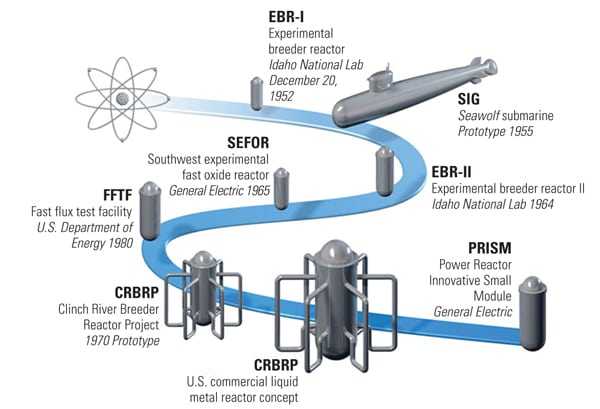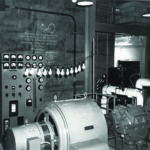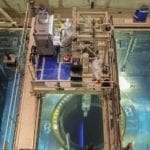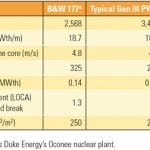In the early 1970s, the liquid metal reactor (LMR) program focused on the construction and deployment of the Clinch River Breeder Reactor (CRBR), a sodium-cooled, fast-neutron reactor near Oak Ridge, Tenn. At that time, the 1,000-MWth-rated CRBR (not to be confused with the plant power rating, in MWe) was viewed as a commercially viable power generation source in the U.S. and a stepping stone to larger, 3,000-MWth commercial plants, the scale thought necessary to be economically competitive with large light water reactors (LWRs).
The CRBR program was a joint effort of the U.S. Atomic Energy Commission, its successor agencies—the U.S. Energy Research and Development Administration and the Department of Energy (DOE)—and the U.S. electric power industry. In addition to encountering legal challenges, cost escalation, and schedule delays over the next several years, the LMR program faced an unexpected challenge: Uranium was not becoming scarce and prohibitively expensive as had earlier been predicted. Work continued on the CRBR until the U.S. Congress terminated funding in 1983 (see sidebar).
The Genesis of PRISM
While the political future of the CRBR was debated, General Electric (GE) employed approximately 1,000 people who were engaged in developing sodium-cooled reactor technology in Sunnyvale, Calif., in the early 1980s. A small group of engineers from GE’s Advanced Reactors program also pursued the idea of developing small modular reactors (SMRs), rated from 100 to 400 MWe. (See “Are Smaller Reactors Better?” November 2010, in the POWER archives at https://www.powermag.com.) One primary advantage of SMRs is the ability to more easily change the size of a facility by adding modules at a particular site. This approach, in 1981, would become the genesis of GE’s Power Reactor Innovative Small Module (PRISM).
When Congress terminated the CRBR program in 1983, the DOE began the advanced liquid metal reactor (ALMR) program. The goal of the ALMR was to increase the efficiency of uranium fuel usage by consuming plutonium and creating conditions where the transuranic isotopes (with atomic numbers greater than uranium, 92) from used nuclear fuel (UNF) would be consumed as well. Following an industry competition, the DOE’s ALMR program selected GE’s PRISM as the preferred reactor technology.
National laboratories, led by Argonne National Laboratory (ANL), were responsible for tackling the fuel cycle separation process. Their research culminated in development of the proliferation-resistant pyroprocessing for UNF recycling, discussed in more detail later in this article. Coupling the ALMR fuel cycle with GE’s PRISM reactor produced the integral fast reactor (IFR) program. The word “integral” was chosen to denote that every step of a complete nuclear power system was being developed simultaneously, and each was an integral part of the whole: the reactor itself, the processes for treating and replacing UNF with new fuel, fabricating new fuel, and treating the remaining waste so it is suitable for disposal. The word “fast” reflected the technical characteristics of the neutrons to achieve nuclear fission at higher energies.
Uniquely for its time, the IFR technology was described as “inherently safe” or “passively safe.” For example, the reactor would respond inherently to events leading to a significant accident by lowering reactor power to safe levels—up to complete shutdown, if necessary—without the need for operator or equipment action. Also, the reactor would respond passively such that no movement of control rods, or any other mechanical device, is needed; nor is any action required by the operators. Therefore, inherent or passive safety depends only on physical phenomena such as convection, gravity, or resistance to high temperatures, not on functioning components.
As part of the ALMR program, a January 1994 review by the U.S. Nuclear Regulatory Commission (NRC) published in NUREG-1368, Preapplication Safety Evaluation Report for the Power Reactor Innovative Small Module (PRISM) Liquid-Metal Reactor, concluded that “no obvious impediments to licensing the PRISM design had been identified.” However, the ALMR/IFR program was terminated later in 1994, with the PRISM reactor less than five years from commercialization.
MOD A, MOD B, and S-PRISM
The very first PRISM was called MOD-A. It had a reactor vessel (RV) diameter of 20 feet and yielded a maximum power output of 170 MWe. That size was selected because it allowed the RV to be shipped by rail. However, this configuration requires three reactors, side by side, to power one steam turbine. The 300-MWe MOD B increased the RV diameter to 30 feet, a design that must be road-shipped, but it would only require one or two reactors, side-by-side, to power one turbine. Despite cancelation of the ALMR/IFR program, GE Hitachi Nuclear Energy (GEH) continued to develop the next-generation 330-MWe S-PRISM reactor (Figure 1, p. 68).
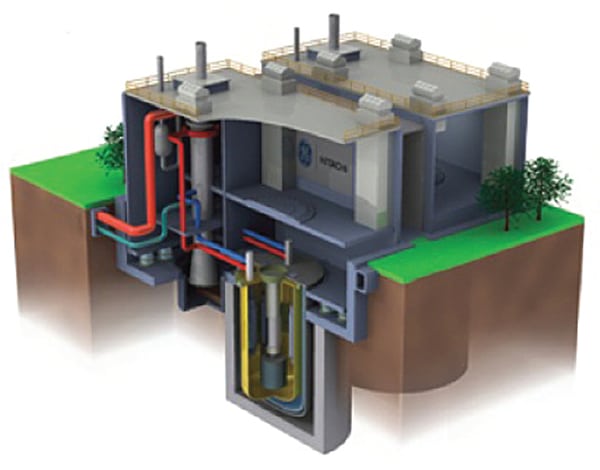 |
| 1. Modular nuclear. In this cutaway view of the PRISM power block, the steam generator is located in the left-front building bay and the two 311-MWe reactor modules are located underground beneath the buildings. Multiple power blocks can be colocated to produce the desired amount of power. Source: GE Hitachi Nuclear Energy |
In all three designs, the technologies that make PRISM unique remained constant: passive reactor core cooling and residual heat removal systems, metallic fuel, and electromagnetic pumps (EMPs). An EMP is designed to move liquid metal or any electrically conductive liquid magnetic material, such as molten salt coolant, using electromagnetic force without a mechanical motor-pump connection.
Remarkable Reactor Design
Nuclear reactors operate on two types of neutrons, based on their energy levels: low-energy (thermal) or high-energy neutrons. In a traditional LWR containing uranium-235 (U-235) as the main component in nuclear fuel, thermal neutrons are used to sustain a fission chain reaction. In order to increase the number of thermal neutrons, hydrogenous materials (such as water) are used to slow down the high-energy neutrons and turn them into thermal neutrons. The thermal neutrons can then be absorbed by U-235, which undergoes further reactions to produce even more neutrons in order to sustain a fission chain reaction.
Reactors, such as the PRISM, utilize the high-energy neutrons for a sustained fission chain reaction. Because PRISM uses liquid sodium as a coolant instead of water, the high-energy neutrons produced from fission do not slow down when they come in contact with the sodium coolant. Sodium becomes a liquid at 208F and boils at 1,621F. Because the PRISM reactor is designed to operate between 640F and 905F, the properties of sodium make it an excellent coolant in a liquid phase with a high heat transfer coefficient.
Additionally, the high-energy neutrons are well suited for fissioning transuranics from commercial LWRs (one of the waste streams) and converting them into short-lived “fission products.” This reaction produces heat energy, which is converted into electrical energy. It also eliminates the need to permanently store the transuranic waste.
Fuel and Reactor Core. Most LWR fuel rods are designed as 14-foot-long assemblies containing uranium oxide. The 10-foot-long metallic PRISM fuel bundles are constructed of an HT9 ferritic alloy and contain a combination of recycled uranium, plutonium, and zirconium. The compact core design requires only 40 fuel assemblies. The fuel is expected to stay in the reactor for about six years, with one-third removed every two years. The used PRISM fuel is then recycled after removal of the fission products.
PRISM has a conversion ratio less than one, which means that the reactor consumes all the fissile material in the UNF, eliminating production of weapons-grade materials. Additional modifications to the core can be made to use either a metal fuel or an oxide-based fuel without changes to the reactor structure or refueling system.
The PRISM core power rating ranges from 800 MWth to 1,000 MWth. The low-pressure pool-type design with a containment vessel surrounding the reactor vessel precludes a large loss-of-coolant accident (LOCA). Therefore, PRISM does not require an emergency core cooling system similar to those in current LWRs (Figure 3).
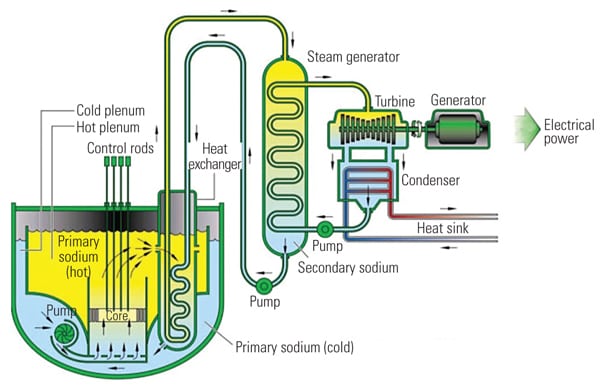 |
| 3. Core contained. The liquid metal–cooled fast breeder reactor “pool” design is illustrated. The heat exchanger loop is immersed in the reactor pool that contains nonradioactive sodium, which is then piped to a different structure that transfers heat to a separate steam loop to produce steam for a conventional steam turbine. Source: DOE |
Intermediate Heat Transport System. The internal EMPs circulate the molten sodium through the reactor core and then to the heat exchanger, located within the reactor vessel. Another sodium loop, a closed-loop system, transports the reactor-generated heat from the internal heat exchanger (IHX) to the steam generator (SG). The hot sodium is transported by pipes from the two IHXs to a single SG. Two high-temperature EMPs in the cold legs return the sodium to the IHX units. The high-temperature secondary EMPs are similar to the ones used inside the reactor core.
These intermediate loops allow reactor operators time to shut down and isolate the primary liquid sodium system should the liquid leak into the intermediate loop. Another reason is that liquid sodium ignites spontaneously when contacting air. In addition, liquid sodium, particularly sodium-24 with a 15-hour half-life, becomes extremely radioactive due to neutron activation during normal reactor operation. By comparison, most radioactive sodium isotopes have half-lives of less than 1 minute, and therefore pose minimal long-term risks. By turning off the pumps in the intermediate loop and halting flow through the steam generator, any radioactivity can be isolated in the primary or intermediate system.
Steam Generator System. The SG provides a high-integrity pressure boundary to ensure separation of the sodium and water/steam. The SG is a vertically oriented, helical coil, sodium-to-water counterflow shell-and-tube heat exchanger. This basic design was developed over 15 years by the ALMR program. Furthermore, a 76-MWth prototype SG was fabricated and tested at the DOE Energy Technology Engineering Center for four years and is the reference design for S-PRISM.
Reactor Vessel Auxiliary Cooling System. The reactor vessel auxiliary cooling system provides ultimate passive, and inherently safe, cooling of the reactor. It is always “on” because it utilizes natural circulation of sodium coolant that constantly removes a small amount of heat (<0.5 MWth) from the reactor modules. For decay heat removal, natural circulation of primary sodium coolant carries heat from the core to the reactor vessel. As containment vessel temperature increases, heat transfer to the atmospheric air increases.
Multiple Barrier Containment System. The multiple barrier containment system consists of fuel cladding, the primary coolant boundary, a lower containment boundary that surrounds the reactor vessel, and an upper containment over the reactor vessel top. The containment boundary is a steel-lined concrete upper structure that encloses the reactor module. Also, the reactor vessel is positioned below grade in a concrete silo, and the liquid sodium level is maintained about 4 feet from the top of the reactor vessel.
Ultimate Shutdown System. Control rods are a part of the standard equipment that includes absorber bundles designed to shut down the reactor in one-fifth of a second. A unique feature of PRISM is the Ultimate Shutdown System, which can be manually actuated if the reactor control rods cannot be inserted into the core to bring the reactor to cold shutdown. When activated, neutron-absorbing spheres containing enriched boron-10, in the form of boron carbide, are dropped into an otherwise empty cavity in the reactor core. The boron spheres absorb the excess neutrons to shut down the reactor.
Memorandum of Understanding
In October 2010, GEH signed a memorandum of understanding (MOU) with the DOE’s Savannah River Site (SRS) in South Carolina. Savannah River Nuclear Solutions LLC (SRNS)—formed by Fluor Corp., Honeywell Corp. Inc., and Newport News Nuclear Inc.—operates and manages SRS for the DOE. The MOU allows for continued discussions on the potential licensing of the PRISM reactor design by the NRC, including the construction and deployment of a 299-MWe unit.
When asked about the readiness of the PRISM design, Dr. Eric Loewen, chief consulting engineer, Advanced Plants Technology for GE Hitachi Nuclear Energy, said that PRISM is a “9” on a scale of “1” (design) to “10” (operations). “We could start construction tomorrow. The conceptual design for PRISM is 100% complete. Much of the detailed design was completed during the Advanced Liquid Metal Reactor Program. Also, the basic underlying physics of PRISM were already tested in EBR-II, an operational sodium fast reactor that is very similar in characteristics and design to PRISM,” said Loewen.
Loewen went on to say that “PRISM would need to have a customer order to submit an official licensing application.” Standard practice is for the reactor vendor and plant owner to submit a licensing application to the NRC, and the case with PRISM should be no different.
“GEH was required to deliver a conceptual design document to the DOE during the Global Nuclear Energy Partnership (GNEP) program,” said Loewen, “and we chose strategically through the company and teaming members to validate, update, and organize our conceptual design document into a draft NRC licensing document. The design control document is comprised of 19 chapters containing over 6,000 pages of information.” This document would serve as the licensing basis for future certification of the PRISM design.
Regarding the future disposition of weapons-grade materials, Loewen added, “We, as a country, have decided to take 33 metric tons of weapons-grade materials, turn that into an oxide, and use it in light water reactors. [Ed. note: See “DOE Project Converts Weapons-Grade Uranium to Fuel for Browns Ferry,” in our December 2006 issue.] President Obama has made it public that he wants to do more to reduce the threat of weapons-grade materials, so we stand ready to help the president by offering the PRISM reactor. Since contaminants or current forms can make it very difficult to purify these materials for use in a LWR, these types of materials are ideal for powering the PRISM reactor. And this is why we signed an MOU with SRS to explore these possibilities.”
Solving the Used Nuclear Fuel Dilemma
Currently, UNF is safely stored in pools of water or in dry casks at U.S. nuclear plant sites. However, 95% of the material in UNF is considered untapped energy that could still be used to generate electricity. PRISM provides a viable means of closing the nuclear fuel cycle by recycling components of UNF, which will use an electrometallurgical separations process called pyroprocessing (Figure 4). Pyroprocessing is a non-aqueous, dry, high-temperature electrochemical procedure used to separate plutonium and other elements from UNF. Electrometallurgical separations technology is widely used in the aluminum industry and has been studied and demonstrated in U.S. national laboratories and the Korea Atomic Energy Research Institute.
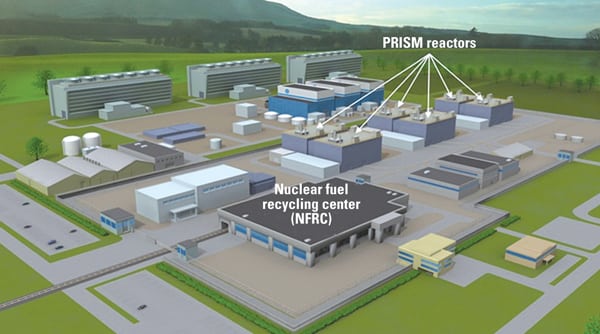 |
| 4. Closed nuclear cycle. GEH has proposed a Nuclear Fuel Recycling Center (NFRC) consisting of an electrometallurgical separations plant and three PRISM power blocks. The NFRC will separate used nuclear fuel (UNF) into three components: uranium that can be used in CANDU reactors or re-enriched for use in light water reactors; fission products (with a shorter half-life) that are stabilized in glass or metallic form for geologic disposal; and transuranics (the long-lived radioactive material in UNF), which are used as fuel in PRISM. Based on current projections of UNF over 60 years, 26 NFRCs are capable of consuming the entire 120,000 tons of UNF in the U.S. Source: GE Hitachi Nuclear Energy |
The processing materials are solids at room temperature. This significantly reduces the risk of an inadvertent environmental release and makes pyroprocessing distinctly different from the Plutonium Uranium Extraction (PUREX) Process. PUREX, in use since 1954 to separate and purify uranium and plutonium from fission products contained in UNF, is a chemical separation process that uses aqueous solvent extraction to perform the separation. However, PUREX processing generates liquid high-level waste requiring storage and eventual vitrification into glass canisters. Furthermore, metallic sodium reacts with water to produce explosive hydrogen gas and corrosive sodium hydroxide that would likely not be acceptable for geologic disposal.
The pyroproccessing process developed by ANL was originally intended for handling UNF from the EBR-II. It is the only technique that has been “licensed” for use on a significant scale. Specifically, the license is based on the Record of Decision for the Treatment and Management of Sodium-Bonded Spent Nuclear Fuel, issued in September 2000. In that record of decision, the DOE, with support from the National Research Council, went on record documenting how it would treat this particular waste form.
Unlike traditional aqueous mixed-oxide (MOX) separation, electrometallurgical separation does not generate separated pure plutonium, making this a proliferation-resistant process. This application is essentially a partitioning-conditioning process, because neither plutonium nor other transuranics are recovered for recycling. As a result, this process produces two new high-level waste forms (metallic and ceramic) to facilitate disposal of a fuel that could not otherwise be sent directly to a geologic repository.
The metal fuel is dissolved in a lithium chloride and potassium chloride molten bath. The uranium is deposited on a solid cathode, while the stainless steel cladding and noble metal fission products remain in the salt and are consolidated to form a durable metallic waste. The transuranics and fission products in the salt are then incorporated into a zeolite matrix, which is hot pressed into a ceramic composite waste. These waste forms do not contain metallic sodium and are therefore suitable for disposal in a geologic repository. The recovered highly enriched uranium could be down-blended to less than 20% enrichment and processed in a metal casting furnace to produce low-enriched or depleted uranium ingots and stored for future use.
What If…?
In a letter to the NRC in March 2009, GE Hitachi indicated that it intends to submit a PRISM reactor design application to the NRC in mid-2011, although in mid-June only the letter of intent has been “updated” and the submittal date is “not determined,” according to the NRC website. Although the science behind the PRISM is proven, the funding sources for building the GEH-proposed Nuclear Fuel Recycling Center and PRISM reactor remain uncertain. In the meantime, the NRC will not begin the official reactor certification process until a customer for the first plant is identified.
Loewen remains optimistic that PRISM will have a seat at the nuclear table. “If we would have continued the ALMR/IFR program, we would have given ourselves a technology portfolio that’s broader than what we have now. We would have a different way to get rid of our used nuclear fuel. The questions of safety have been answered and the problems of nuclear waste can thus be solved; the dispute remains over how to prioritize projects and research in a time of budget restraint.”
— James M. Hylko (jhylko1@msn.com) is a POWER contributing editor.


